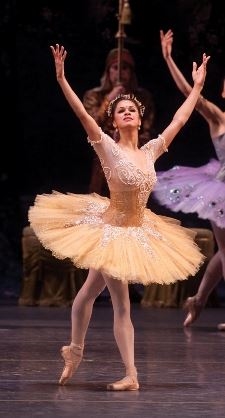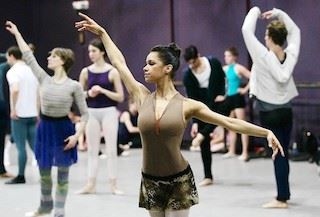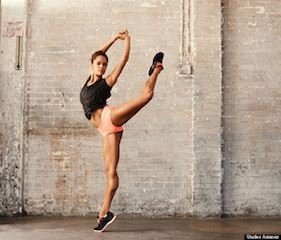 |
| (http://fashionreverie.com/?p=9320) |
 |
| Copeland's first time in pointe shoes at age 13 ( http://alyssamreadingblog.blogspot.com/2014/09/life-in-motion-part-2.html) |
Misty Copeland's impressive resilience in moving past her poor childhood to stardom makes her an excellent hero for children and dancers growing up in poverty. Although she is now spending her time in the spotlight, Copeland's early life was nowhere near as bright as it is now. She had a difficult upbringing, filled with multiple stepfathers and half siblings along the way. With her mother left to take care of all the children on her own, their finances spread thin, and life was unpredictable ("Busting Stereotypes To Become A Prima Ballerina."). "My mother was pretty much a single parent, for the most part. I had stepfathers and we kind of moved around a lot. And I think she was just constantly struggling to raise all six of us kids" ("Busting Stereotypes To Become A Prima Ballerina."). Copeland's family was poor. They did not have much, but that did not stop her from doing great things with her life. She was strong and pushed herself to become a star. Surprisingly, when she was experiencing the deepest poverty was when she was introduced to the art form that would lead her out of it. "And at the lowest point, you know, we were kind of going from home to home and living with friends and sleeping on floors. And right around the time that I started taking ballet classes, I was living in a motel with my five other siblings and my mother." ("Busting Stereotypes To Become A Prima Ballerina."). Ballet saved Misty Copeland's life. It gave her something to work for, and it gave her a place to stay. Her first teacher, Cynthia Bradley, immediately took Copeland under her wing, both at her studio and at her home ("Busting Stereotypes To Become A Prima Ballerina."). The faith in her skill and the new, undivided attention and care she was receiving pushed Copeland to work as hard as she could. Now she is exactly where she had always dreamed of being. So many children are in poverty today and believe there is no hope for them. They do not see themselves as people able to go places or do big things with their lives. Misty Copeland is only one example of a person who came from nothing but accomplished something big. For this reason, she is a hero.
 |
| (http://articles.hbindependent.com/2012-03-28/enter ()) |
Copeland is also a hero to many African- American dancers around the world. Ballet is an extremely traditional art form that has existed since the Renaissance. Although the world around it has grown and evolved, the rules and ideals of ballet, especially with regard to differences in appearance and race, have been reluctant to progress. Misty Copeland was determined to create change in the profession of dance. Most companies and colleges today strive for diversity on their teams and campuses, but ballet companies do not. Misty Copeland may be a talented dancer, but, in the world of ballet, how well you dance is parallel to how you look (Copeland). Being African-American, Copeland stood out too much for ABT's liking, so they were hesitant on pushing her forward in her career. "It's so important for people to understand that just because it's 2014, racism is still real in the world---and in classical ballet." (Copeland). The ideals of what a ballerina should look like are ingrained into ballet companies because of its intense rules and traditions. The ideals are so old fashioned that, even though the world has grown exponentially in tolerance, the ballet community has not (Copeland). Copeland knew it was wrong. She knew she was an amazing ballerina and deserved to be in the company. Her race was not going to determine her future. Part of the reason she was able to face joining ABT was because, for most of her life, she was shielded from the unfairness existing within ballet (Copeland). "My confidence was really born out of a naivete about the prejudices that colored the world of ballet" (Copeland). As people grow up, they begin to notice an ever increasing amount of differences between them and their peers. To children, everyone is equal. To adults, every subtle difference in a person seems to make them somehow better or worse than the next. As a child, Misty Copeland never knew she would have to face discrimination in ballet ("Busting Stereotypes To Become A Prima Ballerina."). She was a good dancer and expected to go far relying on her skills. There was no idea in her mind that, because of her race, she would have to prove herself even more than the other dancers. Her presence in ABT and her success in ballet makes Copeland a perfect role model for young, African-American dancers everywhere ("Misty Copeland On Broadening 'Beauty' And Being Black In Ballet."). Because of her, the rigid, strict nature of ballet is changing for the better. Without Misty Copeland, some talented dancers would possibly go unseen. Because of her, dancers of all races and body types have a place on the stage.
 |
| (http://www.realclear.com/sports/2014/08/04/new_under_armour_ad_proves_ballet_is_one_of_the_fiercest_) |
Her determination to overcome her childhood in poverty, and the unfair discrimination in ballet, is exactly what makes Misty Copeland a hero. She worked so hard to become who she is today, and that was no easy task considering all of the obstacles she had to cross first. Discrimination and poverty are not easy to overcome, but Copeland did. Not only did she overcome these obstacles in her life, but she excelled because of them. Misty Copeland inspires both myself and other people around the world. Her ability to succeed in the ballet world, even with everything she had stacked against her, can be an inspiration to both dancers and non-dancers alike. I take inspiration from Copeland because I am a dancer as well, and I often struggle with feeling like I do not belong. In dance, you are expected to be thin, flexible, beautiful, and capable of doing your makeup and hair with ease. I am not. I am muscular, but not thin. I am a strong and powerful dancer, but not necessarily the most flexible one. I feel beautiful, but sometimes I lose that sense of confidence. I can not do my makeup or hair without at least a little struggle. Misty Copeland inspires me because she was not the ideal dancer in the eyes of ABT, but she became a principal ballerina. She accomplished so much even though there was so much against her. I do not come from poverty. There is no discrimination against me. I have exponentially smaller obstacles in my way. So, if Misty Copeland can do it, then so can I. One last thing that makes Misty Copeland amazing is that, even with the remarkable accomplishments she has made, she remains humble. It took a lot of effort to get where she is today, and she encourages others to do the same. She shows them somebody has faith in them, and that someone has their back. Copeland said, "'There are so many young African-American ballet dancers who stop me on the street or in the subway... They say, 'I want to be just like you, I want to pursue a classical ballet career.' And I say, 'Do it now! No reason to wait. I'm here and I made it.' Hopefully I can set that example so they don't give up."' ("Misty Copeland" Newsmakers).
Works Cited Anderson, Jack. "Misty Copeland." Dancing Times 97.1158 (2007): 104. Biography Reference Center. Web. 3 May 2015. "Busting Stereotypes To Become A Prima Ballerina."NPR. NPR, n.d. Web. 1 May 2015. <http://www.npr.org/2014/03/09/288108214/busting-stereotypes-to-become-a-prima-ballerina> Copeland, Misty, and Charisse Jones. Life In Motion: an Unlikely Ballerina. Print. "Misty Copeland." Newsmakers. Vol. 4. Detroit: Gale, 2015. Biography in Context. Web. 3 May 2015. "Misty Copeland On Broadening 'Beauty' And Being Black In Ballet." NPR. NPR, n.d. Web. 1
Page created on 5/27/2015 12:00:00 AM
Last edited 5/27/2015 12:00:00 AM
